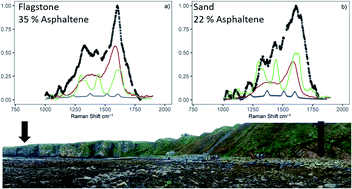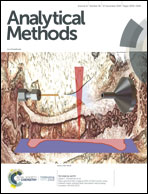The application of surface enhanced Raman scattering to the detection of asphaltic petroleum in sediment extracts: deconvolving three component-mixtures using look-up tables of entire surface enhanced Raman spectra†
Abstract
The detection of asphaltic petroleum by surface enhanced Raman scattering (SERS) is uncomplicated, except in instances where the petroleum has been mixed with other components that also exhibit a strong Raman effect. Such a situation is common where, for example, petroleum is mixed with other naturally occurring materials in sedimentary environments. Sedimentary organic matter in deserts, on beaches, on continental shelves and in the deep sea may contain a variety of compound types that includes pigments and humic compounds, all of which are also amenable to surface enhanced Raman scattering, making the detection of asphaltic petroleum by SERS in these natural environments complicated. However, for a beach-sediment comprising sediment weathered from exhumed petroleum reservoirs and source rocks (naturally occurring sources of petroleum) it can be shown that the asphaltic component of a surface enhanced Raman spectra can be found by deconvolving asphaltene, humic acid and pigments using entire spectra. This is achieved by finding matches on look-up tables comprising entire spectra with varied contributions from different compounds. In using the entire spectra, subjectivity introduced by fitting individual curves to match multiple Raman bands is reduced, minimising the consequences of what can otherwise be a process that involves arbitrary decision making. Using this approach it can be shown that a SERS-assay of asphaltic materials in sediments from a foreshore in Northern Scotland can produce results that benchmark reasonably against standard methods, and data that yields interpretations of the natural environment that are consistent with that derived from comparator GC-MS data.



 Please wait while we load your content...
Please wait while we load your content...